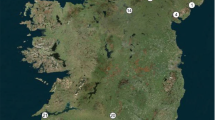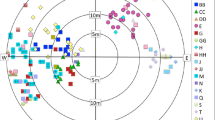Abstract
Festuca idahoensis (Idaho fescue) is a perennial caespitose grass, common in semi-arid rangelands of the Intermountain West. To determine how individuals are recruited into a population, we studied two long-term monitoring plots that were established in 1937 at the Northern Great Basin Experimental Range in southeastern Oregon. The plots measured 3.05×3.05 m, and were located approximately 30 m apart. One plot was ungrazed, the other was subject to moderate levels of cattle grazing. The number of F. idahoensis plants in both plots increased ten-fold between 1937 and 1996, but whether this was due primarily to reproduction by seed or clonal fragmentation was unknown. In 1996, we mapped and sampled 160 plants of F. idahoensis. We used dominant inter-simple sequence repeat (ISSR) markers and codominant allozyme markers in order to identify genetic individuals and measure genetic diversity. Both plots were characterized by high levels of genetic and clonal diversity. When information from ISSRs, allozymes and sample location were combined, 126 genets were recognized, each consisting of one to four samples (ramets). By measuring the diameter of clones surrounding plants that were present in 1937, we estimated that clonal spread occurred at a rate of approximately 3.7 cm per decade, and thus was of secondary importance in the maintenance and increase of F. idahoensis stands. Sexual reproduction, rather than clonal fragmentation, accounted for most of the recruitment of new plants into these plots. The grazed plot had fewer ramets, genotypes, and clones than the ungrazed plot, but the ramets were significantly larger. Levels of genetic diversity did not differ in the grazed and ungrazed plots, but there was some evidence for a small, but significant level of genetic differentiation between the two. The results also indicate that F. idahoensis has the potential to be a long-lived species with some individuals persisting in excess of 60 years. This study demonstrates how long-term monitoring can be supplemented by genetic analysis to obtain detailed information on the population dynamics of plants. In the case of this community dominant species, this provides essential information for understanding succession and developing management and restoration strategies.


Similar content being viewed by others
References
Auquier P (1977) Biologie de la reproduction dans le genre Festuca L. (Poaceae). I. Systèmes de pollinisation. Bull Soc R Bot Belg 110:129−150
Ayres DR, Ryan FJ (1997) The clonal and population structure of a rare endemic plant, Wyethia reticulata (Asteraceae): allozyme and RAPD analysis. Mol Ecol 6:761-772
Blank, S (2001) Resampling Stats for Excel, version 2.0. Resampling Stats, Arlington, Va.
Briske DD, Derner JD (1998) Clonal biology of caespitose grasses. In: Cheplick GP (ed) Population biology of grasses. Cambridge University Press, Cambridge, pp 106−135
Briske DD, Richards JH (1995) Plant responses to defoliation: a physiologic, morphologic and demographic evaluation. In: Bedunah DJ, Sorebee RE (eds) Wildland plants: physiological ecology and developmental morphology. Society for Range Management, Denver, Colorado, pp 635-710
Butler JL, Briske, DD (1988) Population structure and tiller demography of the bunchgrass Schizachyrium scoparium in response to herbivory. Oikos 51:306-312
Camacho FJ, Liston A (2001) Population structure and genetic diversity of Botrychium pumicola (Ophioglossaceae) based on inter-simple sequence repeats (ISSR). Am J Bot 88:1065−1070
Carman JG, Briske DD (1985) Morphological and allozyme variation between long-term grazed and non-grazed populations of the bunchgrass Schizachyrium scoparium var. frequens. Oecologia 66:332–337
Conrad, CE, Poulton CE (1966) Effect of a wildfire on Idaho Fescue and Bluebunch Wheatgrass. J Range Manage 19:138−141
Corradini P, Edelin C, Bruneau A, Bouchard A (2002) Architectural and genotypic variation in the clonal shrub Taxus canadensis as determined from random amplified polymorphic DNA and amplified fragment length polymorphism. Can J Bot 80:205–219
Culley TM, Wallace LE, Gengler-Nowak, KM, Crawford, DJ (2002) A comparison of two methods of calculating G ST, a genetic measure of population differentiation. Am J Bot 89:460-465
Darlington CD, Wylie AP (1955) Chromosome atlas of flowering plants. Aberdeen University Press, Aberdeen
Doyle JJ, Doyle JL (1987) A rapid DNA isolation procedure for small quantities of fresh leaf tissue. Phytochem Bull 19:11−15
Eastman JR (1997) Idrisi for Windows, version 2. Clark Labs for Cartographic Technology and Geographic Analysis, Clark University, Worchester, Maryland
Ellstrand NC, Roose ML (1987) Patterns of genotypic diversity in clonal plant species. Am J Bot 74:123−131
Esselman EJ, Jianqiang L, Crawford DJ, Windus JL, Wolfe AD (1999) Clonal diversity in the rare Calamagrostis porteri ssp. insperata (Poaceae): Comparative results for allozymes and random amplified polymorphic DNA (RAPD) and intersimple sequence repeat (ISSR) markers. Mol Ecol 8:443–451
Gatsuk LE, Smirnova OV, Vorontzova LI, Zaugolnova LB, Zhukova LA (1980) Age states of plants of various growth forms: a review. J Ecol 68:675–696
Gaut BS, Tredway LP, Kubik C, Gaut RL, Meyer W (2000) Phylogenetic relationships and genetic diversity among members of the Festuca-Lolium complex (Poaceae) based on ITS sequence data. Plant Syst Evol 224:33–53
Ge XJ, Sun M (1999) Reproductive biology and genetic diversity of a cryptoviviparous mangrove Aegiceras corniculatum (Myrsinaceae) using allozyme and intersimple sequence repeat (ISSR) analysis. Mol Ecol 8:2061–2069
Gottlieb LD (1981) Gene number in species of Asteraceae that have different chromosome numbers. Proc Nat Acad Sci USA 78:3726–3729
Gupta M, Chyi YS, Romero-Severson J, Owen JL (1994) Amplification of DNA markers from evolutionarily divergent genomes using single primers of simple-sequence repeats. Theor Appl Gen 89:998−1006
Hamrick JL, Godt MJW (1989) Allozyme diversity in plant species. In: Brown AHD, Clegg MT, Kahler AL, Weir BS (eds) Plant population genetics, breeding, and genetic resources. Sinauer, Sunderland, Mass., pp 43–63
Harberd DJ (1961) Observations on population structure and longevity of Festuca rubra L. New Phytol 60:404–408
Harberd DJ (1962) Some observations on natural clones in Festuca ovina. New Phytol 61:85–99
Harberd DJ (1967) Observation on natural clones in Holcus mollis. New Phytol 66:401–408
Harberd DJ, Owen M (1969) Some experimental observations on the clone structure of a natural population of Festuca rubra L. New Phytol 168:93−104
Hartnett DC (1993) Regulation of clonal growth and dynamics of Panicum virgatum (Poaceae) in a tallgrass prairie: effects of neighbor removal and nutrient addition. Am J Bot 80:1114–1120
Hsiao JY, Rieseberg LH (1994) Population genetic structure of Yushania niitakayamensis (Bambusoideae, Poaceae) in Taiwan. Mol Ecol 3:201–208
Jaindl RG, Doescher P, Miller RF, Eddleman LE (1994) Persistence of Idaho fescue on degraded rangelands: adaptation to defoliation or tolerance. J Range Manage 47:54–59
Jauhar PP (1975) Genetic regulation of diploid-like chromosome pairing in the hexaploid species Festuca arundinacea and F. rubra. Chromosoma 52:363–382
Jones JR (1994) Digi-Edit, version 1.0. Tsoft Company, Worchester, Md.
Lehman C (1997) Clonal diversity of populations of Calamagrostis epigejos in relation to environmental stress and habitat heterogeneity. Ecography 20:483–490
Lentz RD, Simonson GH (1986) A detailed soils inventory and associated vegetation of Squaw Butte Range Experiment Station. Special Report 760. Oregon State University Agricultural Experiment Station, Corvallis, Ore.
Lord JM (1993) Does clonal fragmentation contribute to recruitment in Festuca novae-zelandiae? N Z J Bot 31:133−138
Lynch M, Milligan BG (1994) Analysis of population genetic structure with RAPD markers. Mol Ecol 3:91–99
Mack RN, Thompson JT (1982) Evolution in steppe with few large, hooved mammals. Am Nat 124:863–886
Matlaga D, Karoly K (2003) Assessing the consequences of long-term cattle grazing on genetic variation in Idaho fescue (Poaceae) using ISSR markers. J Range Manage (in press)
Mayes SG, McGinley MA, Werth CR (1998) Clonal population structure and genetic variation in sand-shinnery oak, Quercus havardii (Fagaceae). Am J Bot 85:1609−1617
Montalvo AM, Conard SG, Conkle MT, Hodgskiss PD (1997) Population structure, genetic diversity, and clone formation in Quercus chrysolepis (Fagaceae). Am J Bot 84:1553−1564
Nei M (1973) Analysis of gene diversity in subdivided populations. Proc Nat Acad Sci USA 70:3321–3323
Neilson RP (1986) High-resolution climatic analysis and southwest biogeography. Science 232:27–34
Olfelt JP, Furnier GR, Luby JJ (1998) Reproduction and development of the endangered Sedum integrifolium ssp. leedyi (Crassulaceae). Am J Bot 85:346–351
Pappert RA, Hamrick JL, Donovan LA (2000) Genetic variation in Pueraria lobata (Fabaceae), an introduced, clonal, invasive plant of the southeastern United States. Am J Bot 87:1240−1245
Parks JC, Werth CR (1993) A study of spatial features of clones in a population of bracken fern, Pteridium aquilinum (Dennstaedtiaceae). Am J Bot 80:537–544
Pielou EC (1969) An introduction to mathematical ecology. Wiley, New York
Rohlf FJ (1997) NTSYSpc: Numerical taxonomy and multivariate analysis system, version 2.02. Exeter Software, Setauket, N.Y.
Samman S, Wilson, BL, Hipkins, VD (2000) Genetic variation in Pinus ponderosa, Purshia tridentata, and Festuca idahoensis, community dominant plants of California's yellow pine forest. Madroño 47:164−173
Skálová H, Pecháčková S, Suzuki J, Herben T, Hara T, Hadincová V, Krahulec F (1997) Within population genetic differentiation in traits affecting clonal growth: Festuca rubra in a mountain grassland. J Evol Biol 10:383–406
Soltis DE, Haufler CH, Darrow DC, Gastony GJ (1983) Starch gel electrophoresis of ferns: a compilation of grinding buffers, gel and electrode buffers, and staining schedules. Am Fern J 73:9–27
Soltis PS, Soltis DE (2000) The role of genetic and genomic attributes in the success of polyploids. Proc Nat Acad Sci USA 97:7051–7057
Stace CA, Ainscough MM (1984) Continuing addition to the gene-pool of the Festuca rubra aggregate. Plant Syst Evol 147:227–236
Statgraphics Plus, version 3.0 (1997) Statistical Graphics, Rockville, Maryland
Steinger T, Körner C, Schmid B (1996) Long-term persistence in a changing climate: DNA analysis suggests very old ages of clones of alpine Carex curvula. Oecologia 105:94–99
Stewart CN, Porter DM (1995) RAPD profiling in biological conservation: An application to estimating clonal variation in rare and endangered Iliamna in Virginia. Biol Conserv 74:135−142
Stiller JW, Denton AL (1995) One hundred years of Spartina alterniflora (Poaceae) in Willapa Bay, Washington: random amplified polymorphic DNA analysis of an invasive population. Mol Ecol 4:355–363
Suzuki J-I, Herben T, Krahulec F, Hara T (1999) Size and spatial pattern of Festuca rubra genets in a mountain grassland: its relevance to genet establishment and dynamics. J Ecol 87:942–954
Tómas MA, Carrera AD, Poverene M (2000) Is there any genetic differentiation among populations of Piptochaetium napostaense (Speg.) Hack (Poaceae) with different grazing histories? Plant Ecol 147:227–235
Treshow M, Harper K (1974) Longevity of perennial forbs and grasses. Oikos 25:93–96
Watkinson AR, White J (1986) Some life-history consequences of modular construction in plants. Philos Trans R Soc Lond B 313:31–51
Waycott M (1995) Assessment for genetic variation and clonality in the seagrass Posidonia australis using RAPD and allozyme analysis. Mar Ecol Prog Ser 116:289–295
Wendel JF, Weeden NF (1989) Visualization and interpretation of plant isozymes. In: Soltis DE, Soltis PS (eds), Isozymes in plant biology. Dioscorides, Portland, Ore., pp 1–45
West NE, Rea KH, Harniss RO (1979) Plant demographic studies in sagebrush-grass communities of southeastern Idaho. Ecology 60:376–388
Wilson BL (1999) Fescue taxonomy in the Pacific coast states. PhD thesis, Oregon State University, Corvallis, Ore.
Wolfe AD, Liston A (1998) Contributions of PCR-based methods to plant systematics and evolutionary biology. In: Soltis PS, Soltis DE, Doyle JJ (eds) Molecular systematics of plants: DNA sequencing. Kluwer, New York, pp 43–86
Wright S (1951) The genetical structure of populations. Ann Eugen 15:323-354
Yeh FC, Yang R-C, Boyle T (1997) Popgene, version 1.20. University of Alberta, Edmonton
Zietkiewicz E, Rafalski A, Labuda D (1994) Genomic fingerprinting by simple sequence repeat (SSR)-anchored polymerase chain reaction amplification. Genomics 20:176−183
Acknowledgements
We thank David Courtney, Uzi Plitmann, and Jeff Rose for assistance with sampling and field mapping. David Briske, Susan Kephart, Keith Karoly, and two anonymous reviewers provided valuable comments on the manuscript. This study was funded by the USDA Agricultural Research Service.
Author information
Authors and Affiliations
Corresponding author
Electronic Supplementary Material
Rights and permissions
About this article
Cite this article
Liston, A., Wilson, B.L., Robinson, W.A. et al. The relative importance of sexual reproduction versus clonal spread in an aridland bunchgrass. Oecologia 137, 216–225 (2003). https://doi.org/10.1007/s00442-003-1332-2
Received:
Accepted:
Published:
Issue Date:
DOI: https://doi.org/10.1007/s00442-003-1332-2




